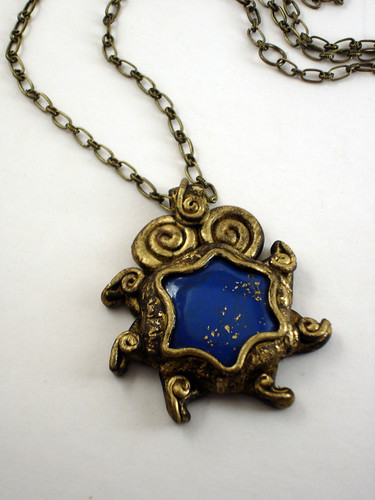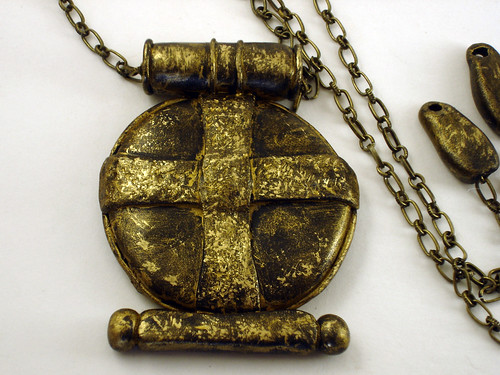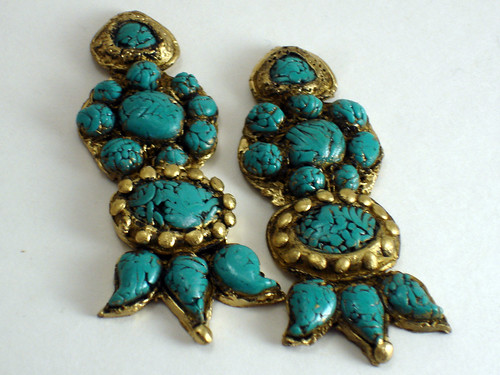Review: Creating Your Own Jewelry by Cris Dupouy

I occasionally watch decorator shows on HGTV, with the hope that one of these days I'll apply their lessons and spruce up my surroundings. One of the shows Tivo faithfully records for me is Sensible Chic, where they take a high-end designer room and recreate it "at a fraction of the cost."
That's kind of what Cris Dupouy's Creating Your Own Jewelry: Taking Inspiration from Museum Masterpieces does. Dupouy gives instructions for re-creating 35 museum-inspired jewelry pieces, using polymer clay, semi-precious stones, acrylic paint, and a few jewelry findings.
The Inspiration Pieces
Drawing her inspiration from as far back as the 7th century B.C., Dupouy uses both actual jewelry pieces and jewelry shown in paintings. Each of the projects starts with a photo and the history of the original piece. This is a nice touch, and would make the book enjoyable for art history buffs. (Art lovers would also enjoy Sue Heaser's Polymer Clay Mosaics, reviewed here, for the same reason.) It made me realize how little I've paid attention to the jewelry in artwork — even the paintings I was familiar with, I hadn't noticed their jewelry. There's a lot of possibilities for inspiration there, far beyond the museum pieces that are in this book.
The Projects
The book includes various levels of projects, but since it's laid out chronologically, the projects aren't in order from easiest to hardest like in many books. I like that Dupouy includes time estimates for each project, breaking it down into preparation time (ranges from 15 minutes to 3.5 hours), baking, cooling, patina and drying time.
Instead of using step-by-step photos for the projects, the book uses gorgeous hand-drawn illustrations. I personally liked this — I thought it was a unique touch that fit with the artistic theme of the book. It might make the instructions more difficult for a beginner to follow, though.
The projects are beginner-level, although the book doesn't cover clay basics that beginners might need to know. Still, there's nothing too complicated here. In fact, in many ways it's the same basic idea again and again. The stones and settings vary, but the technique is always about the same: form the setting from black clay, add texture and some filigree-style embellishments, then bake and patina. Of course, what's not to love about the magic of patina on black clay? (I know I still get tickled when it works well!) So beginning clayers may find themselves hooked, doing project after project. But there's not a lot here for intermediate- and advanced-level clayers, except inspiration.
I'm a bit of a clay purist: one of the things I love is using polymer clay for faux techniques. So I was disappointed that this book didn't include faux instructions for any of its stones — even things like turquoise that would be fairly easy to do. Of course, if that's your thing, you could always combine the jewelry projects in this book with the faux techniques in a book like Irene Semanchuk Dean's Faux Surfaces in Polymer Clay to make some really cool faux projects.
My Results
I tried three projects from this book, and was pretty happy with the results on all of them. I chose to create my own faux blue lapis and turquoise stones with instructions from another book, rather than buying those stones. Here are pictures of my end results:
Summary
- Title: Creating Your Own Jewelry: Taking Inspiration from Museum Masterpieces
- Price: $30 plus shipping
- Pros:
- Its antique jewelry projects are simple to do with beautiful results.
- Serves as a reminder that we can find inspiration in all sorts of places.
- Cons:
- Not a lot of variety in techniques.
- The instructions cover the settings only. No faux techniques for stones here.
- Who It's Good For:
- Beginning clayers who want to try their hand at some simple jewelry-making projects.
- Artists who enjoy reading about (and getting inspired by) historical jewelry pieces.





Comments
Wow! I love what you made. Perhaps YOU should write a book or produce a video. I always enjoy your creations.
Posted by: Madonna | May 9, 2009 4:14 PM
Angela, I forgot to ask. Where do you buy your chain? What type of chain is in the Princess de Broglie's Pendant photo? Thanks!
Posted by: Madonna | May 9, 2009 4:16 PM
Thanks for the compliments, Madonna! Granted, these projects came right from the book. Still, I'd love to write my own polymer clay book!
I bought the chain from my local Hobby Lobby, whose products are often available online through craftsetc.com. I didn't save the packaging, though, so I'm not sure of the type. The book's author recommends recycling old jewelry -- so you might also try looking at garage or estate sales for chains you could reuse.
Posted by: Angela Mabray | May 9, 2009 8:21 PM
Hi! Sorry for my English but I'm Italian.. :)
I've a question for you if you can :)
I bought Makin's professional extruder after I read your post about it :)
I'm so happy because it's so easy to use!! But when I extrude Fimo it goes out cracked to the edges.. Do you know why? what am I wrong?
thanks for the answer :)
Sara
Posted by: Sara | May 10, 2009 2:47 AM
Thanks for the comment, Sara. If I understand correctly, your extruded clay pieces have cracked edges? This is usually caused by clay that is either too dry or needs more conditioning. Make sure you're conditioning it long enough before use, either in your hands or by running it through the pasta machine. If the clay seems extra dry and crumbly (maybe it's from an older package), try mixing in a few drops of baby oil or mineral oil. Hope that helps...
I looked at your site, BTW, and have to say I got hungry just looking at your creations. They look delicious!
Posted by: Angela Mabray | May 10, 2009 10:49 AM
Thanks for the answer Angela! I understands!
I'll try to condition clay more :) and if necessary I'll try with oil :)
Thanks also for the visit to my site and for the compliments!
Sara
Posted by: Sara | May 10, 2009 11:47 AM